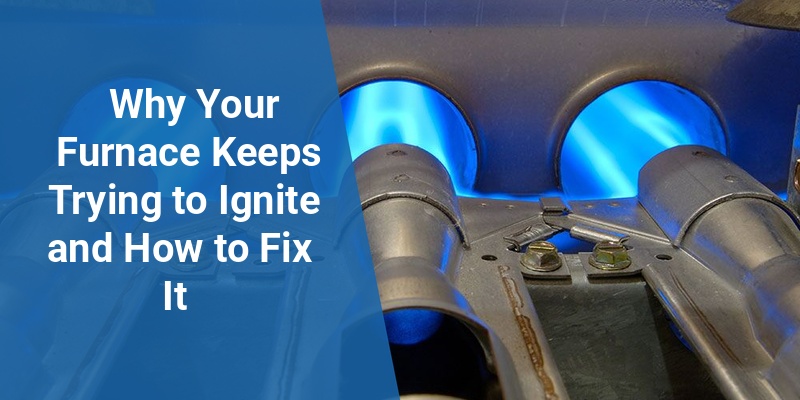A furnace that repeatedly tries to ignite but fails can be both frustrating and concerning, especially during cold seasons. This issue can stem from various mechanical or electrical problems, including faulty ignition systems, dirty burners, or thermostat malfunctions. Recognizing the causes and understanding the necessary steps to troubleshoot these problems can save energy, extend the life of the furnace, and ensure consistent home heating.
| Common Causes | Indicators | Solutions |
|---|---|---|
| Dirty or Faulty Ignitor | Clicking noise without ignition | Clean or replace ignitor |
| Thermostat Malfunction | Continuous cycling on and off | Test and recalibrate or replace thermostat |
| Clogged Burner or Flame Sensor | Intermittent flame or no flame | Clean burner and flame sensor |
| Gas Supply Issues | No gas flow or weak flame | Check gas valve and supply line |
| Faulty Control Board | Repeated ignition attempts without success | Inspect and replace control board if necessary |
How a Furnace Ignition System Works
A furnace ignition system is designed to light the burner flame that heats your home. When the thermostat signals a call for heat, the furnace control board initiates the ignition sequence, which engages the ignitor or pilot light, allowing gas to flow and ignite. If the ignitor repeatedly attempts to start without successful ignition, it indicates an underlying issue in this chain.
The key components involved include the thermostat, control board, ignitor or pilot assembly, gas valve, flame sensor, and burners. Each element must function correctly for the ignition to proceed smoothly.
Common Causes of Continuous Furnace Ignition Attempts
Faulty or Dirty Ignitor
The ignitor, often a hot surface ignitor or spark ignitor, initiates the flame. Accumulated dirt, cracks, or wear can prevent it from lighting the gas burner properly, causing repetitive ignition attempts. Regular cleaning or replacement of the ignitor typically resolves the issue.
Dirty or Faulty Flame Sensor
The flame sensor confirms the presence of a flame and signals the control board to keep the gas valve open. If dirty or malfunctioning, it may not detect the flame even when present, prompting the furnace to shut the gas valve and try igniting again. Cleaning the flame sensor removes buildup and improves ignition reliability.
Gas Supply Issues
Insufficient or interrupted gas flow can prevent ignition. This may be caused by closed valves, gas line blockages, or problems with the gas regulator. Checking the gas supply and ensuring valves are open is essential to restoring proper ignition.
Thermostat Problems
A malfunctioning thermostat that sends inconsistent signals can cause the furnace to keep cycling through the ignition process. Thermostat troubleshooting or replacement can stabilize the ignition process.
Call 888-906-9139 for Free Local HVAC Quotes – No Obligation, Just Savings!
Faulty Control Board
The control board governs the ignition sequence. Faults, such as electrical issues or software glitches, can trigger continuous ignition attempts. Technical inspection and possible replacement of the control board may be necessary.
How to Troubleshoot a Furnace That Keeps Trying to Ignite
Proper troubleshooting requires safety precautions, including turning off power and gas supply before inspection. Here’s a guide to diagnose the issue:
- Check Power and Gas Supply: Ensure the furnace is powered and the gas valve is open.
- Inspect the Ignitor: Look for cracks or dirt buildup and replace or clean as needed.
- Clean the Flame Sensor: Gently clean with fine sandpaper or steel wool to remove residue.
- Test the Thermostat: Verify the thermostat’s settings and operation; recalibrate or replace if faulty.
- Examine the Control Board: Identify error codes or signs of damage and replace if necessary.
Preventive Maintenance Tips for Furnace Ignition Systems
Regular maintenance is vital to avoid ignition problems. Key preventive steps include:
- Annual professional furnace inspection: Detects wear or faults early.
- Routine cleaning of ignitor and flame sensor: Keeps components functioning efficiently.
- Ensuring proper airflow and clearing obstructions: Prevents burner issues.
- Replacing air filters regularly: Helps maintain furnace efficiency and ignition reliability.
When to Call a Professional HVAC Technician
If troubleshooting does not resolve the furnace ignition issue or if you encounter gas leaks, strange odors, or unsafe conditions, contact a licensed HVAC technician immediately. Professional servicing ensures accurate diagnosis, safe repairs, and avoids hazards related to gas appliances.
Energy Efficiency and Safety Concerns
Repeated ignition attempts consume energy and wear out furnace components prematurely. Additionally, failed ignition can cause gas buildup, increasing the risk of fire or explosion. Promptly addressing the root cause protects your household and reduces utility bills.
